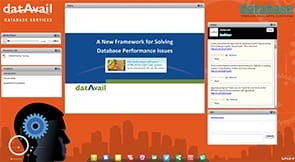A New Framework for Solving Database Performance Issues
Get Answers with the 5S Approach

If your organization relies on data, optimizing the performance of your database can increase your earnings and savings. Many factors large and small can affect performance, so fine-tuning your database is essential. Vice President and Practice Leader, Development, Tuning, and Automation for Datavail, Chuck Ezell, sheds light on the right questions to get the answers that will help you move forward by using a defined approach, referred to as 5S.
These five areas help organize the tuning approach and define the major concerns beyond the architecture, setup, and data model. It also addresses how performance tuning becomes less of a mystery if it can be measured, documented, affected, and improved.
Show Transcript
Below is a preview of the webinar transcript.
This is the landscape that we are facing. Bank of America online was down for 6 days, affected 29 million online customers. Gmail was down for 2 days, caused by a software update affecting 120,000 users. Virgin Blue's reservation desk was down for 11 days, and affected 50,000 passengers and 400 flights. It cost millions in profit. Netflix was down for 4 to 8 hours. It affected 20 million customers, and potentially it was due to some software deployment issues that they termed as internal technical issues. Paypal battled on and off service outages for about 5 days in October, 2004, after they upgraded their site. They blamed the glitches on the software update that they did.
Whether we're talking about Bank of America, or Gmail, Netflix, Intuit, Blackberry, Amazon, Yahoo, all of these customers, all of these companies face performance issues. Many times we're dealing with reactive fixes. I know you guy are probably facing these issues every day. What's our methodology? What's our approach? How do we fix these things that really surprise us? Because most often our performance problems are not related to installing a whole new database environment, or brand new hardware installs. Many times they are just daily things that happen, changes to the movable parts, if you will, in the database. Things like application code changes, data model changes, data growth, configuration changes. Why do we performance tune? This is an obvious question, right?
Fill out the form to the right to watch the webinar in its entirety. >>
Watch The Webinar Here